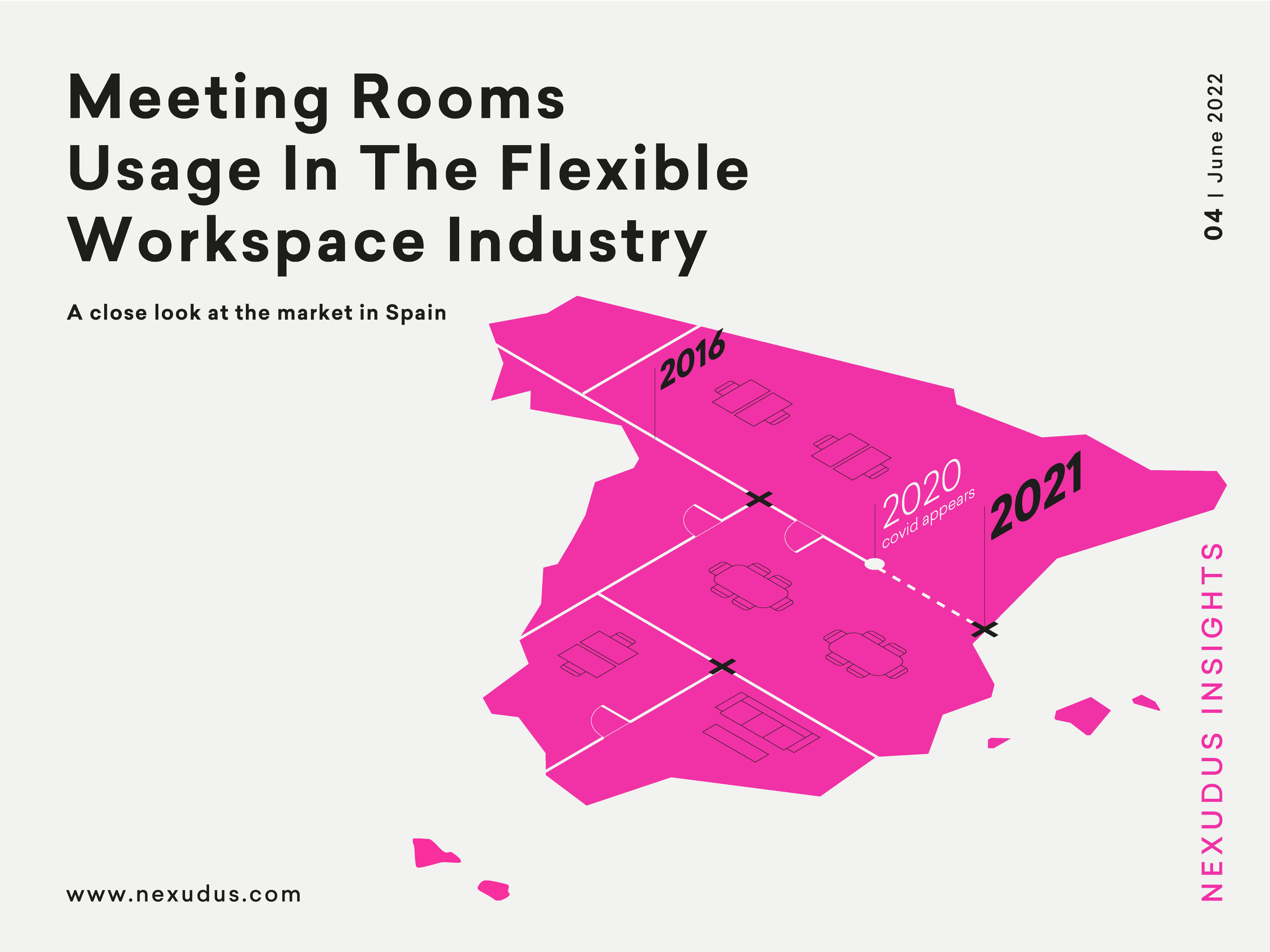Nexudus Insights: Comparing Three Markets
A few months ago Nexudus started the Nexudus Insights project with the intention of helping all operators of flexible workspaces gain a deeper understanding of the industry through a unique and rational look at the data. We started with a global study based on 3.5 million anonymised records from 90 countries over the last 6 years.
The first four reports in the series have covered the global market, as well as the US, UK and Spanish markets. The intention has been to provide an overview starting from a global perspective and then moving down to look at each of these three markets separately and in more detail. In this article, we want to share with you some of the aspects that have caught our attention when looking at these three markets comparatively.
The reports that cover these three markets in detail answer the same questions around resource usage and in particular, in this article, we want to share with you some of the insights on the duration of bookings, the capacity of the most popular resources, the price of bookings and which size of space gets the most benefit from the use of its resources in each market.
Resource: an element that a space makes available to its users. These are usually physical spaces such as a meeting room, a hot desk, an event room or a booth, but can also be tools such as laser cutters, 3D printers, or a drum kit in a music rehearsal room.

Our most recent report is available to download now!
Looking at the three markets, we find different realities and commonalities between them. One that I personally find most interesting is the maximum capacity of the resources that receive the most bookings. While in all markets resources with a capacity of nine or fewer users receive between 70 and 80% of the bookings, these percentages are distributed very differently in each market.
In the United States, the resources with the most reservations are those with a maximum capacity of up to 3 users, while in Spain they are those with between 4 and 5 users and in the United Kingdom those with a capacity of between 8 and 9 users. It is also worth noting that it is in the United States where the most disparate behaviour is observed in terms of the resources that receive a number of reservations depending on the number of members that the space has, while in the United Kingdom there is less divergence between them.
This should matter to you if you want to build a new space or want to improve the performance of existing resources. Building on existing space is not easy, but it is worth doing if it can improve profitability, conversion or satisfaction.
Another key aspect we have covered in this series of reports is the income that spaces get from resource bookings made by contacts (users who are not members of the space) as this represents an important source of revenue for flexible workspaces.
In the UK and Spain, bookings made by contacts have an average final price between 66% and 64% higher than that of a member, while in the US they only represent an increase of 36%.
Spain and the UK also have in common the fact that the largest venues, with more than 250 members, followed by those with between 100 and 250 members, are the ones where contact bookings have the highest final price.
This should matter to you if you are not making enough profit from lead bookings as they are an important bonus that can supplement the revenue of your space. Especially if you are in a market like the UK or Spain.
Another interesting aspect is how spaces monetise the resource bookings made by their members. I find it particularly interesting to understand how, and at what price, users consume resources at different rates.
In the US market, users on the office rate are those who pay, on average, a higher hourly rate for their bookings, while in the UK and Spain it is the users on the virtual rate. It is worth noting that when we look at the uniqueness of the US market we see that spaces with more than 250 members are those that obtain a price per hour for these bookings that is up to 50% higher than the bookings made by office rate users in spaces with fewer members.
This data should matter to you if you are assessing which type of user is more profitable for your space. You should not only take into account the revenue you get from memberships but also the extra revenue they give you by, for example, booking resources.
These are just some of the data that you can find in the reports that the Nexudus team has prepared for you, but there is much more data in them that can be relevant to improving space management and operation. If this post has left you wanting more, visit Nexudus Insights to download these free reports to learn more about the market you are most interested in.
Related stories
Global Coworking Trends and Opportunities for 2025
Now well into 2025, the coworking industry continues to demonstrate strong momentum. With demand for coworking spaces remaining steady around the globe, it's clear that coworking is not just enduring—it's thriving. Let’s explore the major trends and opportunities shaping the global coworking landscape this year.
Creating Events that Drive Community Engagement in Coworking Spaces
Community is everything in coworking, but a genuine sense of connection between members doesn’t magically happen overnight or by chance. Often, meaningful relationships take intentionality, effort, and time to build, with events being an effective vehicle for bringing people together around shared interests, goals, and experiences, creating opportunities for collaboration, and a thriving coworking culture. This article looks at creating events that drive community engagement in coworking spaces.
Liz Elam: ‘Community is the number one amenity in coworking spaces’
A household name in the global coworking industry, Liz Elam, is the founder of one of the world’s best coworking event series: GCUC. Liz’s coworking roots began in 2010, when she established Link Coworking – a welcoming, affordable, and professional coworking space – in her hometown of Austin, Texas. Link Coworking achieved incredible success, expanding across three locations and becoming the fourth-largest coworking brand in Austin. It was sold in 2019, making Liz the first woman globally to exit a coworking brand.
Key Takeaways from the Coworking Alliance Summit 2025
Gathering online for the Coworking Alliance Summit last week, members of global coworking alliances, coworking spaces, and community leaders came together to navigate global issues, strengthen ties across the coworking industry, and work collectively towards future goals.
5 Ways to Reduce Noise in Open Offices & Coworking Spaces
Some people like working against a background of noise, while for others it’s their worst work nightmare. The truth is, our relationship with noise depends on our own preferences and the nature of our work.
Key takeaways from the Workspace Design Show 2025
London’s Workspace Design Show is undoubtedly one of the best coworking events of 2025. For one, the exhibition (held at Islington’s Business Design Centre) features a host of innovative and creative workspace design solutions tailored to the needs of modern workplaces.
What Is Workplace Management and Why Does It Matter?
There has always been a need for workplace management – the process of organising and optimising physical spaces, resources, and operations to support people’s needs. But, as 28% of UK working adults were reported to work in a hybrid capacity last autumn (by the Office for National Statistics), the question of ‘why workplace management matters’ is more critical than ever. Let’s look at the workplace management benefits for your operations.
10 Smart Goals for your Coworking Space: How to Set & Achieve Business Objectives
Coworking is synonymous with creativity, collaboration and productivity. Businesses and freelancers love coworking spaces because (by surrounding themselves with fellow workers) they’re more likely to achieve their goals. The coworking environment, while social, is set up to facilitate focused, distraction-free working.
The Best Coworking Events in 2025: Must-Attend Gatherings for Professionals
Managing coworking spaces is an all-encompassing role, often leaving operators, owners, and community managers with little time to focus on personal growth or draw inspiration from others.
10 Award-winning Coworking Space Designs: A Comprehensive Guide
Vibrant, contemporary workspaces create an undeniable ‘wow’ factor. Textured designs and ambient lighting make spaces feel warm and cosy, while natural elements and biophilic design features have literal mood-boosting properties.

